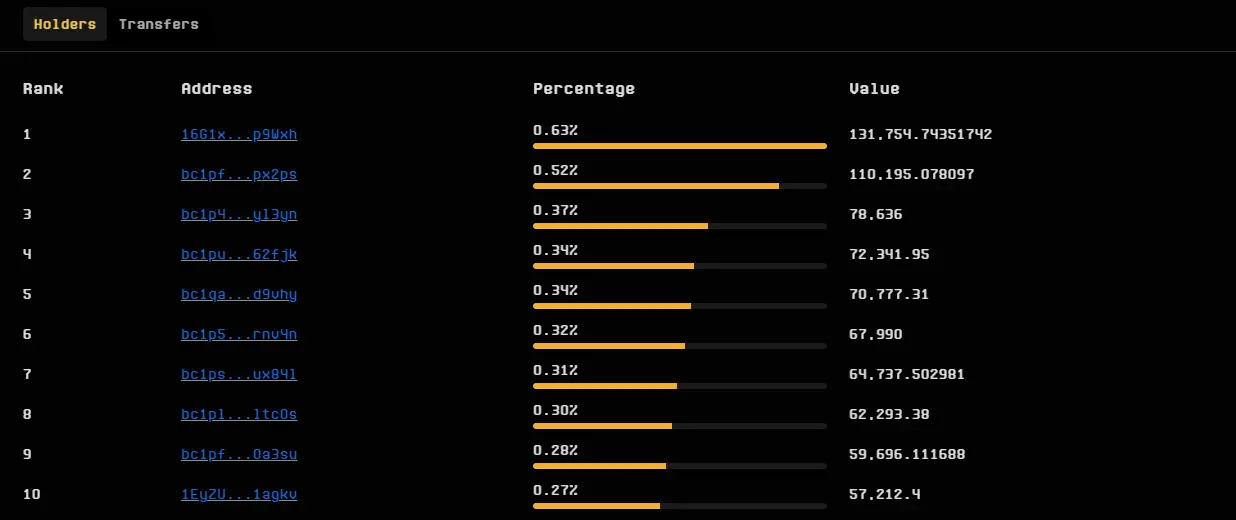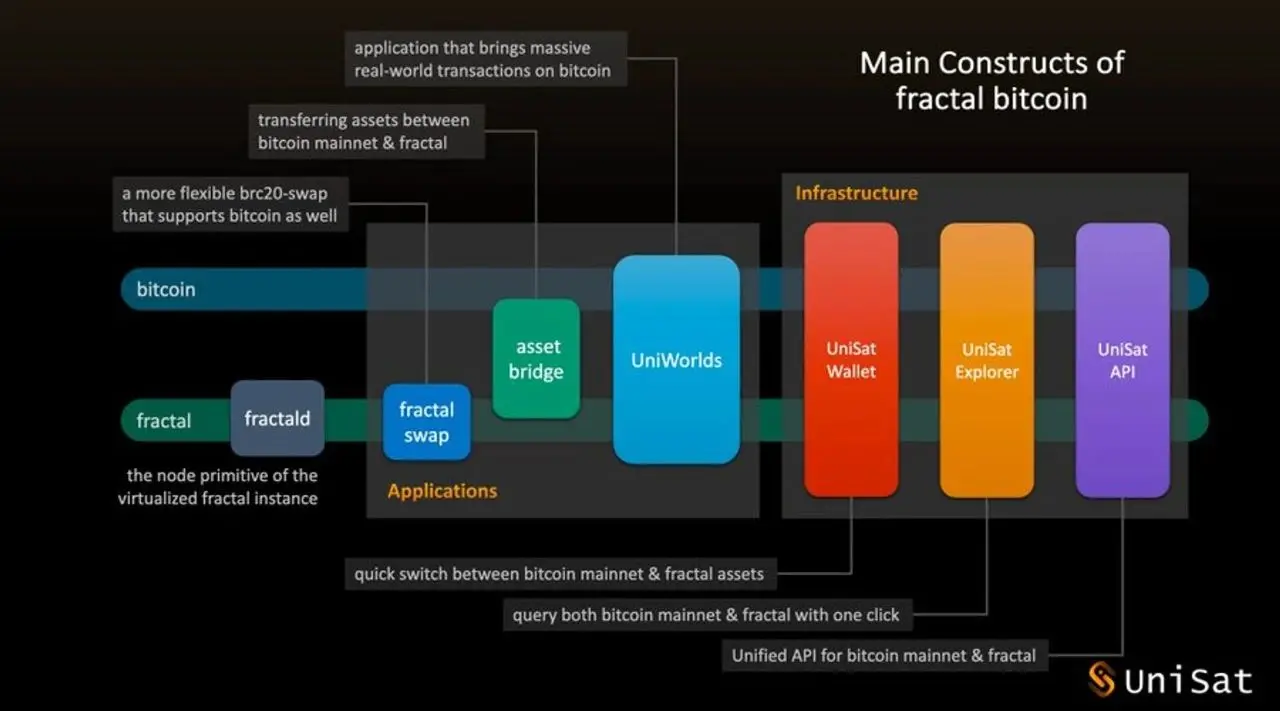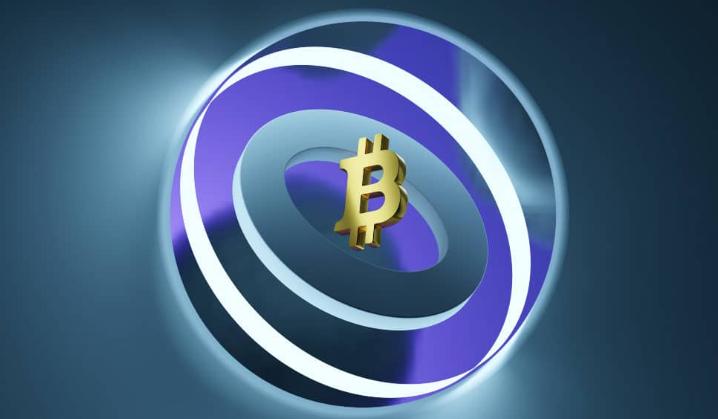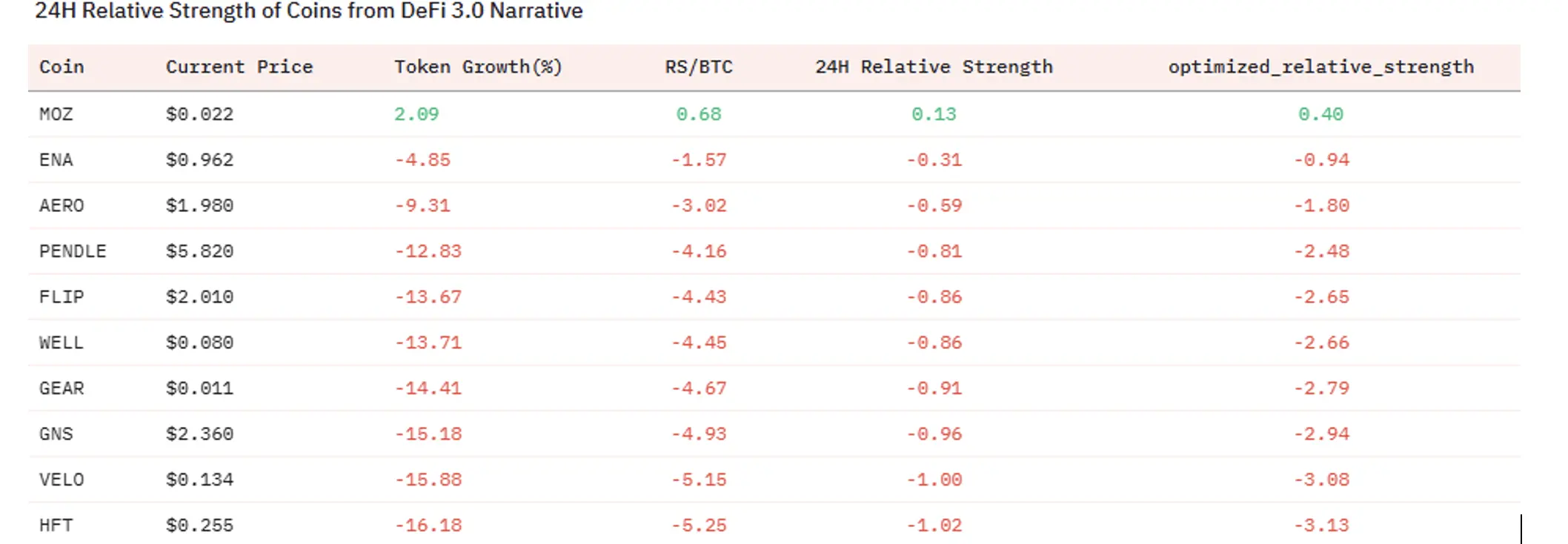Unisat: Pulling BRC-20 back to greatness with three carriages
Preface
With the continuous development of the Bitcoin ecosystem, the number of users and transaction volume has significantly increased. However, since the emergence of Ordinals and the BRC-20 token protocol, the Bitcoin network has faced severe challenges in scalability and transaction efficiency. Especially during active market periods, high Gas fees and on-chain congestion have led to failures in inscription and rune transactions, making small-cap users hesitant to enter the field.
To address these issues, an increasing number of projects have joined the research and development of Bitcoin scaling solutions, such as Nubit and STRK. Among them, the most notable is the UniSat team. Over the past six months, the UniSat team has collaborated with L1F (Layer 1 Foundation) to promote the standardization of brc20-swap on Layer 1, making it part of the BRC-20 standard upgrade, and has preliminarily verified that its product Unisat Swap can operate normally on the Bitcoin mainnet. Additionally, the UniSat team has received investments from major exchanges OKX and Binance, providing strong financial support for its development.
In addition to promoting the standardization of Swap, the UniSat team has systematically "fractalized Bitcoin" through a method called Fractal Bitcoin. UniSat will launch a Swap product named Fractal Swap, which has the same functionality as the mainnet Swap module, ensuring that projects on Fractal Bitcoin have good liquidity from the start. In subsequent iterations, Bitcoin and other mainnet assets can also exist as BRC-20 wrapped assets on Fractal Bitcoin, providing greater flexibility.
Recently, many hot events surrounding UniSat have attracted widespread attention. For example, SATS will be used as the Gas fee on the UniSat platform, and UniSat has also issued Pizza airdrops to users who have interacted with the platform in the past. Coupled with the ongoing Fractal Bitcoin Fractal Swap product, these initiatives are important steps for UniSat to promote the resurgence of BRC-20. This article will first conduct a basic analysis of PIZZA and SATS inscriptions, exploring their historical background and holding address situation. Finally, this article will delve into the concept and application of Fractal Bitcoin, comparing it with major competitors Runes and RGB++, exploring its potential and prospects in scaling the Bitcoin network. Through the discussion of these topics, we hope to provide readers with insights into the current development of the Bitcoin ecosystem and future possibilities.

1. The Purpose of Unisat------AMM Mechanism DEX on BRC20
The founder of BRC20, Domo, established an organization called Layer 1 Foundation, appointing several leading BRC20 indexers as collaborators, including Unisat. The data storage of the BRC20 standard is in Segregated Witness, so the indexers in the BRC20 standard are modifiable. Unisat aims to achieve a fully compliant AMM mechanism DEX on Layer 1 by modifying the indexers in the BRC20 standard, similar to decentralized automated market makers like Uniswap and 1inch. Currently, both OKX and Unisat's BRC20 market transactions are not automatically matched; instead, they require orders to be placed and wait for buyers to take them, similar to trading NFTs.
Based on this goal, Unisat is conducting a series of narratives and empowerment to facilitate the DEX of the AMM mechanism.
2. SATS Designated as Gas Fee---Application Attributes
2.1 Basic Introduction
SATS is the ninth inscription token on the BRC-20 protocol, fully known as satoshis, which is the smallest unit of bitcoin, abbreviated as "satoshi." 1 BTC = 100 million satoshis. The total supply is 21 trillion, corresponding to 21 million BTC.
On July 7, UniSat officially confirmed again that Unisat swap and Fractal Bitcoin are both based on the BRC-20 protocol and use BRC-20 SATS as gas fees. As the largest wallet hub in the BRC-20 ecosystem, UniSat not only supports SATS as the gas fee for swaps but also uses it as the base trading token for brc20swap. This initiative has brought a large number of active users to SATS, and most importantly, it has empowered SATS with application attributes.
2.2 Event Analysis
The $SATS consumed as Gas Fee will form a destruction economic model, promoting the deflation of $SATS.
The first wave of positive news has already been released, and the second wave of positive news will wait until Fractal Bitcoin is officially launched.
2.3 Holding Address Analysis
According to the OKX inscription trading platform, SATS currently has a market value of 9,817 BTC, approximately $620M, with 48,297 holders.

Source: OKX Figure 1.1
As shown in Figure 1.2, the top ten holding addresses of SATS indicate that the chips are concentrated, with the largest holder accounting for 43.82%, showing a clear main force.

Source: Unisat Figure 1.2
3. Pizza Airdrop---Meme Attributes
3.1 Basic Introduction
Years ago, someone used 10,000 BTC to buy two pizzas, an event that gave BTC a real price and had a critical historical impact on the entire cryptocurrency industry. The Pizza inscription was born based on this historical significance and endowed with meme attributes.
Pizza is the official airdrop inscription of UniSat and is the first five-character inscription. The total supply of the five-character inscriptions officially airdropped by UniSat is 21 million, all distributed through airdrops. The maximum number of odd-numbered airdrops does not exceed 18,000, with a large and dispersed number of holders.
3.2 PIZZA Airdrop Rules
The airdrop quantity for each address is generally 100 pieces. Based on the total supply of 21,000,000, it is estimated that over 200,000 wallets were airdropped at that time. The following are the conditions for claiming pizza:
(1) Addresses that have interacted with UniSat services within the last 3 months.
(2) Addresses holding more than 500 UniSat points.
(3) Addresses that have interacted within the brc20-swap module.
(4) Holders of UniSat OG Pass can all receive this inscription.
3.3 Holding Address Analysis
According to the OKX inscription trading platform, pizza currently has a market value of 1,461 BTC, approximately $93M, with 100,255 holders, which is about half of the number of airdrop wallets.

Source: OKX Figure 2.1
As shown in Figure 2.2, the top ten holding addresses of pizza indicate that the holding addresses are too dispersed, with a very large number of holders, and there is no obvious main force among the holding addresses.

Source: Unisat Figure 2.2
4. Fractal Bitcoin------Platform Attributes
4.1 Basic Introduction:
Fractal Bitcoin is a method of virtually recursively expanding the processing capacity of the Bitcoin network. It uses the Bitcoin core code to achieve the coexistence and coordination of multiple instances while maintaining consistency on the Bitcoin mainnet, aiming to achieve infinite scalability while ensuring consensus consistency and network security by preserving the engineering structure of the Bitcoin system.
As shown in Figure 3.1, simply put, it is like a Layer 2 for BTC, forking the BTC code and adjusting the block confirmation time (adjusted to confirm within one minute). Additionally, it is expected to be more aggressive than the main chain, such as supporting op_cat and other prohibited features.

Source: Unisat Figure 3.1
4.2 Main Architecture:
The infrastructure of Bitcoin and the fractal network is connected and operated through a node (fractald).

Source: Unisat Figure 3.2
Applications:
Fractal swap: A more flexible BRC20 exchange mechanism that also supports Bitcoin. Asset bridge: A bridge for transferring assets between the Bitcoin mainnet and the fractal network. UniWorlds: An application that brings a large number of real-world transactions into the Bitcoin network.
Infrastructure:
UniSat Wallet: A wallet that allows for quick switching between the Bitcoin mainnet and fractal assets. UniSat Explorer: A browser that can query the Bitcoin mainnet and fractal network with one click. UniSat API: A unified API that can be used for both the Bitcoin mainnet and the fractal network.

Source: Unisat Figure 3.3
4.3 Limitation Analysis:
Limitations of DEX: The DEX that Unisat ultimately implements can achieve BRC20 to BRC20 swaps, but theoretically cannot achieve BTC to BRC20 swaps because the BTC standard does not conform to the BRC20 standard.
BTC Data Structure Not Suitable for Trading and Smart Contracts: Completely mimicking BTC's data structure can indeed ensure security, but it is not the optimal choice, as BTC's data structure is not very friendly for trading and smart contracts.
Testnet Speed is Fast but Actual Confirmation Speed May Vary: Although the testnet is fast, the current confirmation speed of the BTC mainnet is about 10 minutes or even longer, which limits speed. Unless future product updates introduce innovative mechanisms, the speed issue is difficult to improve.
4.4 Competitor Analysis:
4.4.1 Runes:
The "Runes" solution leverages two key mechanisms of the Bitcoin blockchain: the UTXO (Unspent Transaction Output) transaction model and the OP_RETURN opcode.
In the UTXO transaction model, each transaction generates outputs that serve as different units of digital currency. To initiate a new transaction, these outputs are used as inputs. This model allows for precise tracking of each cryptocurrency unit. For Bitcoin runes, each UTXO can contain different amounts or types of runes, making token management easier.
The OPRETURN opcode allows users to embed additional information in Bitcoin transactions. This opcode supports including up to 80 bytes of unusable extra data in transactions. "Runes+UTXO" uses the OPRETURN opcode to store token data, including the token's name, ID, symbol, specific operation commands, and other basic information. This data is stored in so-called rune stones, using the OP_RETURN field of Bitcoin transactions.
Based on the token deployment process, BRC-20 tokens create a new inscription each time they are deployed, minted, or transferred. Additionally, each token is stored in a separate UTXO. The protocol does not specify how to include multiple tokens within a single UTXO, leading to UTXO inflation.
Runes simplifies this process. First, it no longer uses BRC20 but stores data in the OP_RETURN field. Second, it allows users to hold multiple tokens, including Bitcoin, within the same UTXO, making transfers more efficient and reducing UTXO inflation. Third, Runes is 100% based on UTXO, meaning it can be more easily integrated into RGB or Lightning.
4.4.2 RGB++ Layer:
The RGB++ Layer achieves 1:1 interaction between Bitcoin and Turing-complete UTXO chains (such as CKB) through isomorphic binding, simplifying off-chain verification, enhancing user experience, and supporting multi-chain interoperability and BTCFi applications, such as UTXOSwap and IBO platforms.
Fractal Bitcoin creates recursive BCSP instances by virtualizing the Bitcoin core, achieving horizontal and vertical blockchain scaling, providing infinite computing power and fast block confirmations, supporting applications like Ordinals instances and virtual worlds, while preserving the consensus mechanism and engineering structure of Bitcoin.
Architecture: The RGB++ Layer achieves cross-chain interoperability through isomorphic binding and non-bridge cross-chain, while Fractal Bitcoin achieves multi-layer computing and storage expansion through virtualized recursive expansion of the Bitcoin core.
Consensus Mechanism: The RGB++ Layer relies on joint consensus between Bitcoin and UTXO chains, while Fractal Bitcoin maintains a consensus mechanism consistent with the Bitcoin main chain, enhancing robustness through recursive instances.
User Experience: The RGB++ Layer simplifies user experience, reducing the complexity of off-chain verification, while Fractal Bitcoin enhances user experience and transaction efficiency through virtualization and fast confirmations.
The RGB++ Layer focuses on cross-chain interoperability and user experience optimization, suitable for BTCFi and asset liquidity aggregation, while Fractal Bitcoin achieves infinite scaling and multi-layer computing through virtualization, suitable for applications with complex computing and storage needs, each with its own advantages.
5. Conclusion
In summary, as the Bitcoin network faces challenges in scalability and transaction efficiency, innovative solutions such as RGN++ and Fractal Bitcoin have emerged. UniSat, by standardizing brc20-swap and introducing Fractal Bitcoin, provides users with a more flexible trading mechanism and greater network processing capacity. UniSat has empowered the BRC-20 ecosystem by using SATS as a gas fee and the meme attributes of Pizza, attracting a large number of users. Although Fractal Bitcoin has certain limitations in structure and implementation, its potential for infinite scaling and multi-layer computing architecture demonstrates the future development direction of the Bitcoin network. In comparison with competitors like Runes and RGB++ Layer, Fractal Bitcoin showcases its unique technical characteristics through virtualized recursive expansion and consensus consistency; however, theoretically, it does not currently outperform Runes and RGB++. We hope that more innovative mechanisms will be introduced when the product is officially launched.
Disclaimer: Readers are advised to strictly comply with local laws and regulations; this article does not constitute any investment advice.













